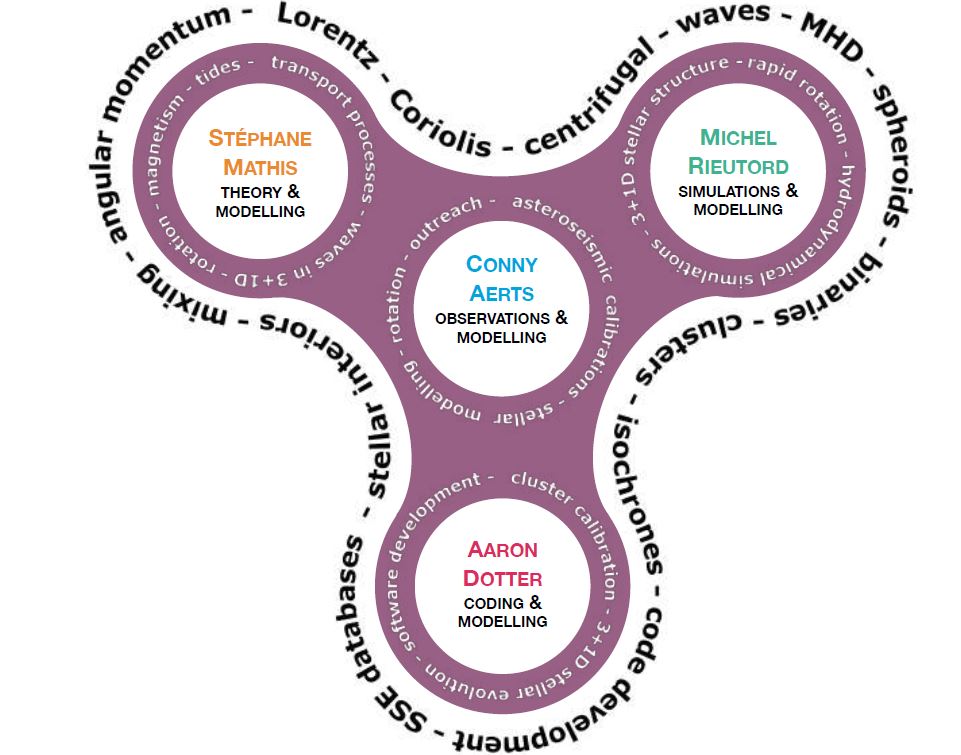The four principal investigators receive almost 10 million euros for their project 4D-STAR, which will develop and deliver innovative numerical models of rotating magnetic stars in three spatial dimensions throughout their evolution.
ERC Synergy Grants of the EU's research and innovation programme Horizon Europe, help groups of two to four outstanding researchers bringing together complementary skills, knowledge and resources in one ambitious overarching project, addressing some of the world’s most formidable research problems. The projects typically span multiple scientific disciplines - in the case of 4D-STAR astronomy, theoretical physics, fluid mechanics, applied mathematics, computer science and software development.
Stars are the source of radiation, chemistry, and life in the Universe. Given their fundamental role in astrophysics, a great deal of effort has gone into observing stars, both from the ground and from space. Space asteroseismology, also known as the study of starquakes with satellites, is providing transformational knowledge of the internal structure, evolution, dynamics, and magnetism of stars. Indeed, these starquakes are due to waves that pass through the stars and allow researchers to deduce the physical and chemical properties of their interiors. However, to deduce basic properties of most objects in the Universe, such as age, chemical composition or energy, astrophysicists rely on simplified one-dimensional stellar models treating stars as perfect spheres. This approach, which neglects the flattening of stars due to their rotation and the multidimensional dynamical processes in their interior, provides an unstable basis for astrophysics, introducing major uncertainties in stellar ages of up to 1000%!
Asteroseismic data from the CoRoT, Kepler, and TESS space missions, astrometry from the Gaia space mission, and spectroscopic data obtained from the ground with high-precision instruments for the entire sky are now, or will soon be, publicly available for millions of stars in our Milky Way and its closest neighboring galaxies, the Magellanic Clouds. Building on this goldmine of optimal public data and state-of-the-art analysis tools, the four principal investigators propose with 4D-STAR a new concept to develop, implement, and calibrate a 3+1D theory for stellar evolution (in three spatial dimensions and one temporal dimension), taking full account of rotation, magnetism, turbulent transport processes, and waves throughout the life of spheroidal stars. Adequate 3+1D models must take into account the impact of these dynamical processes acting on short time scales and small spatial scales on the whole stellar life cycle over millions/ billions of years. They must then reproduce the measured properties of the internal rotation and stellar magnetism. The 4D-STAR project will therefore overcome the main shortcomings of current 1+1D stellar evolution models and provide stellar ages with an accuracy of 10% (100 times better than today) by building numerical stellar models for 3+1D flattened spheroids.

Figure caption: The complementary expertise of the four principal investigators summarised in a spinner diagram, as an overall representation of the SyG 4D-STAR. Figure courtesy of Dr. Clio Gielen, KU Leuven, Belgium.
“With 4D-STAR, the four of us embark upon a long journey together, with the aim to offer a new solid foundation to astrophysics, by constructing 3-dimensional evolution models of rotating magnetic stars, calibrated by asteroseismology.” says coordinating PI Conny Aerts. As a leading figure of asteroseismology, she develops pioneering stellar models calibrated by observed starquakes to constrain rotation and mixing in stars. “This lifting of stellar models to higher dimensions is optimally started now, using asteroseismic data of thousands of stars in all dominant life phases.” she continues.
“Asteroseismology makes it strikingly clear that current 1-dimensional models cannot explain the high-precision observations of starquakes and that a new theory of stellar structure and evolution is required.” says PI Aaron Dotter from Dartmouth College, who develops astrophysical software in a worldwide setting. “But to achieve that, Conny and I need help from our two French colleagues.”
“Indeed, to build these new stellar models a transdisciplinary approach is needed, combining astrophysics, fluid dynamics, mathematical modelling, and computational science.” confirms PI Michel Rieutord from Toulouse University, leader in astrophysical fluid dynamics and developer of pioneering 2-dimensional models of rotating stars.
PI and theoretical astrophysicist Stéphane Mathis from CEA Paris-Saclay, explains: “With our SyG we will develop a new generalised mean field theory of transport processes for 3-dimensional rotating and magnetic stellar fluids, as input for 4D-STAR’s software development and simulations, while adhering to the asteroseismic data to ensure properly calibrated models. After 2 years of joint preparation, we are excited to start our 4D-STAR adventure and to offer our tools to the astrophysics community”
This 4D-STAR project is part of Irfu's core activity in the framework of the preparation and scientific exploitation of the ESA PLATO space mission, in which it is strongly involved, as well as in the development of high performance computing within the CEA.
Contact Irfu: Stéphane Mathis
Presse release of the ERC (25 octobre): Twenty-nine groups backed by ERC Synergy Grants to tackle complex research questions
• Structure and evolution of the Universe › Planets, star's formation and dynamics, interstellar medium
• Institute of Research into the Fundamental Laws of the Universe • Department of Astrophysics (DAp) // UMR AIM
• Laboratory Dynamics of Stars, Exoplanets and their Environment
